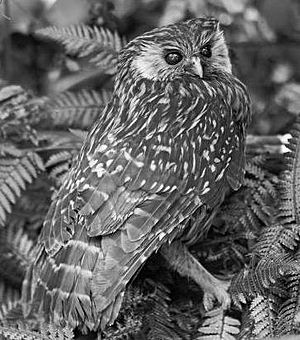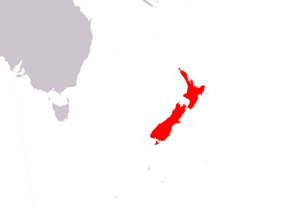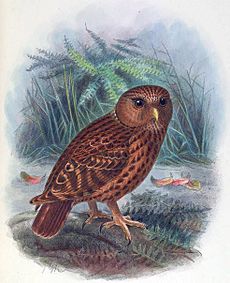Laughing owl facts for kids
Quick facts for kids Laughing owl |
|
|---|---|
 |
|
| Live N. a. albifacies specimen photographed between 1889 and 1910 | |
| Conservation status | |
| Scientific classification | |
| Genus: |
Ninox
|
| Species: |
albifacies
|
| Subspecies | |
|
|
 |
|
| Range of N. albifacies Extinct | |
The laughing owl (Ninox albifacies), also known as whēkau or the white-faced owl, was a special type of owl that lived only in New Zealand. When European settlers first arrived, there were many of these owls. Scientists officially described the species in 1845. Sadly, by 1914, most or all of them had disappeared.
This owl was once thought to be in its own unique group called Sceloglaux. This name meant "scoundrel owl," probably because of its funny calls. However, new studies of its DNA show that it belongs with other "boobook owls" in the group called Ninox.
Contents
About the Laughing Owl
Different Types of Laughing Owls
There were two main types, or subspecies, of laughing owls. The smaller type, N. a. rufifacies, lived on the North Island of New Zealand. People thought they might have been found near Mount Taranaki and the Wairarapa area. For a while, some wondered if they ever lived on the North Island at all. But later, many old bones of these owls were found there. This proved they definitely lived on the North Island.
On the South Island, the larger type, N. a. albifacies, lived in drier areas. These included places like Nelson, Canterbury, and Otago. They were also found in the central mountains and possibly Fiordland. Some specimens were even collected from Stewart Island/Rakiura around 1881.
How Scientists Study Them
Scientists have studied many specimens of the laughing owl. This includes 57 owl bodies and 17 eggs that are kept in museums. These collections help us learn more about the birds, even though they are no longer alive.
A study in 2016 looked at the owl's DNA. This study confirmed that the laughing owl is part of the Ninox group. It seems to be a close relative to other owls like the barking owl and the morepork. The morepork is another owl that also lived in New Zealand.
Description of the Laughing Owl
The laughing owl had yellowish-brown feathers with dark brown stripes. It had white stripes on its shoulders and sometimes on the back of its neck. Its wings and tail had light-brown stripes. The feathers on its legs were yellowish to reddish-brown.
The owl's face was white around and below its eyes. This white faded to grey with brown stripes closer to the center of its face. Some owls had more reddish-brown feathers and a brown face. Scientists first thought this was due to different subspecies. But now they believe it was just a natural difference between individual owls. Males might have had richer colors. The owl's eyes were a very dark orange.
Laughing owls were about 35.5 to 40 centimeters (14 to 15.7 inches) long. Their wings were about 26.4 centimeters (10.4 inches) long. Males were usually smaller than females. An adult owl weighed around 600 grams (about 1.3 pounds).
Vocalisations (Sounds)
The laughing owl got its name from its call. People described it as "a loud cry made up of a series of dismal shrieks frequently repeated." Other descriptions included "a peculiar barking noise, just like the barking of a young dog" or "precisely the same as two men 'cooeying' to each other from a distance." Some heard a "melancholy hooting note" or a high-pitched chattering. These sounds were often heard when the owls were flying, especially on dark, drizzly nights or just before rain.
One person even claimed that laughing owls were attracted to accordion music! This might have worked because the sound of a distant accordion could have sounded like the owl's call.
Ecology and Behaviour
Laughing owls usually lived in rocky, dry areas. In the North Island, they were also found in forests. They ate many different things. Their prey included beetles, wētā (large insects), birds, and geckos. After European settlers arrived, they also ate rats and mice.
These owls seemed to hunt on the ground. They would chase their prey on foot instead of flying to catch it. We know a lot about their diet from their pellets. Owls cough up these pellets, which contain the undigested parts of their food, like bones and fur. These pellets have helped scientists learn about the small animals that lived in New Zealand long ago. For example, pellets from one owl roosting site contained bones from 28 different bird species, a tuatara, frogs, geckos, a skink, bats, and fish!
The owls' diet usually matched the small animals living in their area. They ate prions (small seabirds) if they lived near sea bird colonies. They also ate snipe, kākāriki (parrots), and even large earthworms. When Pacific rats were brought to New Zealand, the laughing owls started eating them too.
Laughing owls were still quite common when European settlers arrived. Because they were large, they could also hunt the European rats that were introduced. However, stoats and feral cats were also introduced to New Zealand. These new predators were too much for the laughing owls to handle.
Reproduction and Life Cycle
Laughing owls started breeding in September or October. They made their nests on the bare ground, often in rocky ledges, cracks in rocks, or under large rocks. They lined their nests with dried grass.
The female owl would lay two white, roundish eggs. These eggs were about 44-51 millimeters (1.7-2 inches) long and 38–43 millimeters (1.5-1.7 inches) wide. The eggs took about 25 days to hatch. During this time, the male owl would bring food to the female while she sat on the nest.
Extinction of the Laughing Owl
By 1880, the laughing owl was becoming very rare. Only a few more specimens were collected. The very last officially recorded laughing owl was found dead at Bluecliffs Station in Canterbury, New Zealand, on July 5, 1914.
There have been some unconfirmed sightings since then. The last unconfirmed reports from the North Island were in 1925 and 1927. In the 1940s, someone reported hearing a laughing owl near Ōpōtiki. In 1956, an unknown bird with a "weird cry" was heard in Fiordland. Even in 1960, fragments of laughing owl eggs were supposedly found in Canterbury.
The main reasons for the laughing owl's extinction were:
- Hunting: People hunted them, mainly to collect specimens for museums.
- Habitat Loss: Changes in how land was used, like clearing forests, destroyed their homes.
- New Predators: The introduction of predators like cats and stoats was a major problem. These new animals hunted the owls directly.
For a long time, people thought the owls died out because they couldn't compete with new predators for food like the kiore (Pacific rat). However, kiore were also an introduced animal. The laughing owl originally ate small birds, reptiles, and bats. They probably also ate introduced mice later on. It seems more likely that these gentle, unwary birds were directly hunted by the new predators, which led to their extinction.
See also
 In Spanish: Sceloglaux albifacies para niños
In Spanish: Sceloglaux albifacies para niños






